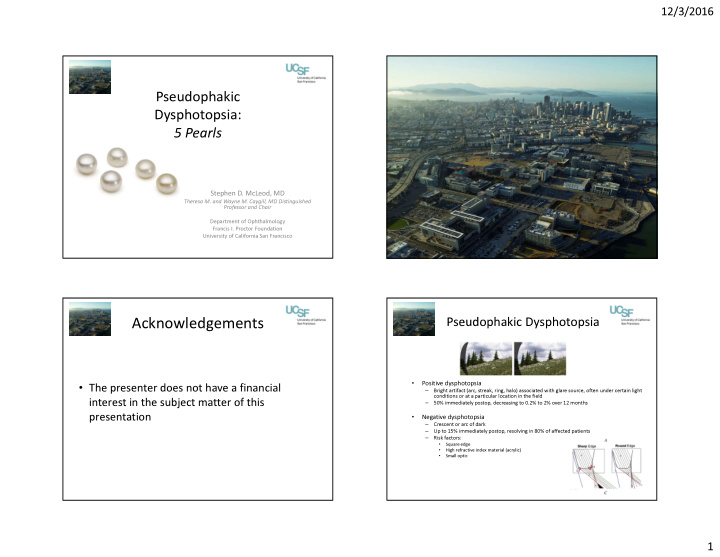



12/3/2016 Pseudophakic Dysphotopsia: 5 Pearls Stephen D. McLeod, MD Theresa M. and Wayne M. Caygill, MD Distinguished Professor and Chair Department of Ophthalmology Francis I. Proctor Foundation University of California San Francisco Pseudophakic Dysphotopsia Acknowledgements • Positive dysphotopsia • The presenter does not have a financial – Bright artifact (arc, streak, ring, halo) associated with glare source, often under certain light conditions or at a particular location in the field – interest in the subject matter of this 50% immediately postop, decreasing to 0.2% to 2% over 12 months • presentation Negative dysphotopsia – Crescent or arc of dark – Up to 15% immediately postop, resolving in 80% of affected patients – Risk factors: • Square edge • High refractive index material (acrylic) • Small optic 1
12/3/2016 Pseudophakic Dysphotopsia Pseudophakic Dysphotopsia Pearl 1 • Your surgery will most Pearl 2 likely be perfect— centered, on optic capsulorhexis • Pilocarpine doesn’t • The patient doesn’t want work to hear how perfect your • (some reports actually surgery was… suggest improvement • Acknowledge the with dilation) problem Pseudophakic Dysphotopsia Pseudophakic Dysphotopsia Pearl 3 • Perception of dysphotopsia may be a learned phenomenon • Be patient: Holladay argues that • 44% of patients with dysphotopsia in one eye also spontaneous resolution of symptoms might be due to had it in the contralateral eye, regardless of IOL progressive opacification of the anterior capsule that diffuses incident light • Resolution has also been attributed to “neuro-adaptation” 2
12/3/2016 Pseudophakic Dysphotopsia Pseudophakic Dysphotopsia • Anterior optic-posterior iris Pearl 4: Patients become sensitized distance might be a factor: consider sulcus placement or reverse optic • Don’t blame the dysphotopsia on the capture (prolapse the optic forward IOL and promise that a different IOL out of the bag) in the contralateral eye will prevent problems in the second eye • For the affected eye: once dysphotopsia has appeared and persists, in-the bag-IOL exchange with a different IOL type often fails Pseudophakic Dysphotopsia Pseudophakic Dysphotopsia Pearl 5 Pearl 5 • Read the literature • Prevention ? carefully! • Is light reflected from uninterrupted temporal lens edge the problem? • Prospective trial placing haptic- 1. Listen to the patient optic junction at the 2. No pilo inferotemporal location in each eye 3. Be patient • POD1: 5% dysphotopsia in 4. Once experienced, the inferotemporal group vs 14% of patient is sensitized: no vertical group guarantees • 1 week and 1 month: no difference 5. Three R’s: R ound edge, R everse optic capture, R otate 3
Recommend
More recommend